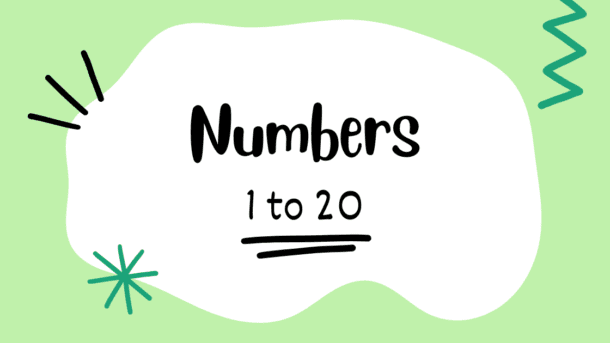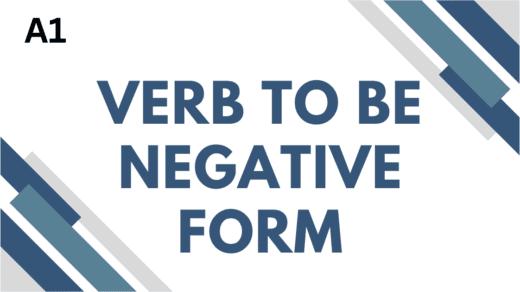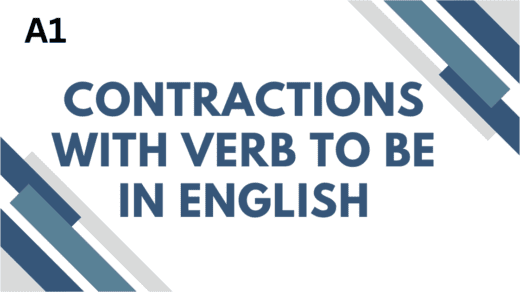Understanding English Numbers:
English Numbers play a significant role in our daily lives, and learning to count is a fundamental skill in any language. In this blog post, we will explore the English numbers from 1 to 20, focusing on their pronunciation, spelling, and usage in sentences. By the end of this lesson, students will be able to recognize, pronounce, write, and use the English numbers from 1 to 20. They will also understand their application in everyday situations such as counting, telling time, and basic arithmetic.
Understanding Uses of English Numbers
- Basic Arithmetic:
Introduce simple addition and subtraction using numbers 1 to 20. Present problems such as, “If you have 3 apples and you buy 2 more, how many do you have?” Write these problems on the board and solve them together. - Telling Time:
Briefly teach students how numbers relate to telling time. For example, point to a clock and highlight the numbers used to indicate the hour and minute. - Daily Applications:
Discuss how these numbers appear in daily life situations like age, phone numbers, and addresses. This contextualizes the importance of learning them.
The Basics of English Numbers
Before we dive into the individual numbers, it’s important to recognize why knowing numbers is essential. Numbers are useful in countless daily tasks: from shopping and telling time to managing finances and understanding age or calendar dates. In English-speaking countries, familiarity with numbers is not merely academic; it extends to social interactions, timeliness, and civic engagement
The English Numbers in Detail
- One (1) -Pronounced /wʌn/, “one”.
- Example: I have one apple.
- Two (2) – Pronounced /tuː/, “two”.
- Example: There are two birds in the tree.
- Three (3) – Pronounced /θriː/, “three”.
- Example: She has three dogs.
- Four (4) – Pronounced /fɔːr/, “four”.
- Example: They found four leaves.
- Five (5) – Pronounced /faɪv/, “five”.
- Example: He scored five points.
- Six (6) – Pronounced /sɪks/, “six”.
- Example: We need six chairs for the meeting.
- Seven (7) – Pronounced /ˈsɛv.ən/, “seven”.
- Example: Seven continents exist on Earth.
- Eight (8) – Pronounced /eɪt/, “eight”.
- Example: She has eight crayons.
- Nine (9) – Pronounced /naɪn/, “nine”.
- Example: He turned nine years old last week.
- Ten (10) – Pronounced /tɛn/, “ten”.
- Example: There are ten fingers on your hands.
- Eleven (11) – Pronounced /ɪˈlɛv.ən/, “eleven”.
- Example: The clock shows eleven o’clock.
- Twelve (12) – Pronounced /twɛlv/, “twelve”.
- Example: I bought twelve eggs.
- Thirteen (13) – Pronounced /ˈθɜːr.tiːn/, “thirteen”.
- Example: She is thirteen years old.
- Fourteen (14) – Pronounced /ˈfɔːr.tiːn/, “fourteen”.
- Example: There are fourteen days in two weeks.
- Fifteen (15) – Pronounced /ˈfɪf.tiːn/, “fifteen”.
- Example: He weighs fifteen pounds.
- Sixteen (16) – Pronounced /ˈsɪk.stiːn/, “sixteen”.
- Example: She can drive at sixteen.
- Seventeen (17) – Pronounced /ˈsɛv.ən.tiːn/, “seventeen” .
- Example: I met him when he was seventeen.
- Eighteen (18) – Pronounced /ˈeɪ.tiːn/, “eighteen”.
- Example: You can vote at eighteen.
- Nineteen (19) – Pronounced /ˈnaɪn.tiːn/, “nineteen”.
- Example: Our class has nineteen students.
- Twenty (20) – Pronounced /ˈtwɛn.ti/, “twenty”.
- Example: Twenty years have passed.
| 1- One | 2=Two | 3= Three | 4=Four | 5=Five | 6=Six |
| 7=Seven | 8=Eight | 9=Nine | 10=Ten | 11=Eleven | 12=Twelve |
| 13=Thirteen | 14 Fourteen | 15=Fifteen | 16=Sixteen | 17=Seventeen | 18=Eighteen |
| 19=Nineteen | 20=Twenty |
Understanding the Structure of English Numbers:
The first ten numbers, 1 through 10, are unique in that they do not follow a particular pattern in their naming. However, from 11 to 19, the naming convention starts to show a slight pattern. Numbers 11 and 12 are distinct, while 13 through 19 are formed by taking the root number and adding the suffix “teen.” For example, “three” becomes “thirteen,” and “four” becomes “fourteen.”
Once you reach 20, the naming structure shifts again. “Twenty” serves as a base for numbers that go beyond 20. Knowing these patterns makes it easier to learn and memorize higher numbers as well.
Usage in Daily Life
Numbers from 1 to 20 are ubiquitous in everyday English. Here are some common applications:
- Counting: Children start counting objects at a young age, learning the sequence of these numbers first.
- Time: Telling time often involves the numbers from 1 to 12 in the context of hours each day.
- Prices: In shops, prices often range from 1 to 20 for items, making this knowledge crucial for transactions.
- Age: People often refer to age using these numbers, especially for children.
Tips for learning English numbers 1-20 effectively:
- Repetition: Regularly recite the numbers aloud to improve pronunciation and retention.
- Visual Aids: Use flashcards with the number on one side and the word on the other for visual recognition.
- Counting Objects: Practice counting everyday items, like fruits or toys, in English to reinforce learning.
- Songs and Rhymes: Listen to songs or nursery rhymes that emphasize numbers to make learning enjoyable.
- Games: Engage in interactive games that involve numbers, such as bingo or matching games.
- Write Them Out: Practice writing the numbers to reinforce their spellings alongside their numerical forms.
- Digital Apps: Utilize language learning apps that focus on number recognition and pronunciation.
Consistent practice and diverse methods will help reinforce your learning!
How to Teach the English Numbers (Pronunciation and Writing)
- Number Chart:
Create a number chart from 1 to 20 on the whiteboard. Write both the numeral and the word.NumberWord1 One, 2 Two, 3 Three, 4 Four, 5 Five, 6 Six, 7 Seven, 8 Eight, 9 Nine, 10 Ten, 11 Eleven, 12 Twelve, 13 Thirteen, 14 Fourteen, 15 Fifteen, 16 Sixteen, 17 Seventeen, 18 Eighteen, 19 Nineteen, 20 Twenty - Pronunciation Practice:
Go through each number, emphasizing proper pronunciation. Use audio recordings for additional help. Students should repeat each number aloud several times. - Writing Practice:
Provide students with worksheets where they can trace and write each number. Encourage them to focus on correct spelling and formation of letters.
Engaging Activities
- Counting Objects:
Hand out counting objects like blocks or beads. Have students count and group them in numbers from 1 to 20. Ask them to say the number out loud as they count. - Number Flashcards:
Use flashcards showing numerals on one side and the written word on the other. Students can match numerals to their corresponding words individually or in pairs. - Number Bingo:
Create bingo cards with numbers 1 to 20. Call out numbers randomly, and students mark them on their cards. This reinforces number recognition and promotes listening skills. - Role-Playing:
Set up a mock store scenario where students can practice their counting and number skills. Give them play money and have them “buy” items priced with numbers from 1 to 20. This will help them understand how numbers operate in real life. - Games:
Introduce simple number games like “What’s Missing?” where a number is removed from the chart, and students have to guess which one it is. Another fun game is “Number Hop,” where you call out a number, and students jump to the corresponding numeral on the floor.
Conclusion
Understanding English numbers from 1 to 20 lays the foundation for further mathematical concepts and everyday communication. Familiarity with these numbers will enhance your counting skills, improve your grasp of basic mathematics, and boost your confidence in using English in various contexts. Whether you’re a beginner or looking to refresh your knowledge, mastering these numbers is an essential step in learning the language.so the next time you encounter numbers, remember their stories, structures, and significance. Whether you are teaching, learning, or just brushing up on your English skills, embracing these fundamental numerals can offer a gateway to understanding more complex concepts in the language and beyond.
Keep practicing, and you’ll find that counting in English numbers is not just easy – it’s also fun!




